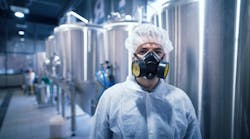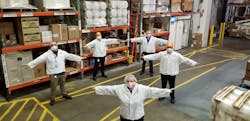What went right?
It’s not a question most companies focus on. More emphasis is on what mishaps took place and how to correct them. But sometimes, it’s just as important to study what went right and then replicate it.
This is exactly the case for HP Hood, a 175-year-old company that manufactures dairy and other products across 13 plants in the U.S. Faced with how to keep employees safe while simultaneously keeping production going when COVID-19 hit, the company has a history to lean on.
“Our past activities were very helpful in being able to respond to the pandemic,” explains Dave Crowley, senior EHS leader at HP Hood. “Prior to this pandemic, we had a business continuity plan that identified different types of crises that can occur. We had that pandemic continuity plan in 2008 when H1N1 virus hit, but looking in the rearview mirror, it was mild compared to the pandemic.”
However, Crowley said he, like other EHS professionals, was up to the task. “It’s fair to say that COVID-19 changed the job description for EHS professionals. We launched into action and responded to the call of duty. Every day was spent deciding how to combat the virus and control whatever measures we could.”
New control measures for HP Hood ranged from setting up temperature stations to hiring on-site nurses to set up break rooms as outside tents. “Tents were replaced with temporary trailers for the inclement weather months,” Crowley says. “Several of our facilities underwent expansions to accommodate more of a long-term solution.”
Safety measures were also taken outside of the plant by the company’s drivers and engineering teams. Drivers quickly transitioned from paper and manual signatures required by customers to contactless deliveries to enable social distancing and limit contact with paperwork. Likewise, engineering and maintenance teams set up new handwashing stations as well as break room facilities to allow for social distancing.
“Everyone adapted well to these changes,” says Crowley, who has been with the company for 22 years. “Working in the food industry, we are expected to have standard operating procedures focused on food safety. We brought human safety to the same level as food.
“Employees respected that and actively participated in whatever measures were added. There was never an objection to these measures or a reluctance on the part of employees.”
The key to success—there were no COVID-19 fatalities or production shutdowns—relied on the company’s culture when it came to employee safety. “As a company, when the pandemic hit our first thought was: How can we protect our employees? Our approach was to use the theme ‘When we protect our employees, we also protect their family members,’” Crowley says.
This theme was helpful when communicating with the company’s 3,400 employees. “We didn’t want to limit our messaging to workplace safety. We wanted to promote the benefits of safety at home as well. We’ve used this theme repeatedly over the past 20-plus months, driving home the core value of safety and emphasizing the impact [of] a strong workplace safety culture with our employees’ family members.”
Not Everyone Fared So Well
Unfortunately, the food manufacturing industry, which employs around 3.4 million people, has had a very tough time containing COVID-19 among workers. This was especially true for the meatpacking industry, which had 269 deaths and 59,000 cases due to COVID-19, as revealed by the U.S. House Select Committee on the Coronavirus Crisis, which examined internal documents from the five largest meatpacking companies.
The report concluded that more could have been done to protect workers and that some companies were slow to take protective steps, including distributing personal protective equipment, installing barriers and conducting temperature screenings. In addition to the health toll on employees, production in the industry fell to 60% of normal in the spring of 2020, as facilities were closed due to worker shortages, safety upgrades and deep cleaning.
The Occupational Safety and Health Administration has stepped in to help. In August 2020, the agency issued a comprehensive 16-page checklist specifically for food manufacturers as they “continue, resume or reevaluated operations due to the coronavirus pandemic.”
Moreover, the union representing food manufacturing workers, The United Food and Commercial Workers International Union (UFCW), is calling upon the government to further increase safety standards as COVID-19 continues to affect the health of workers. On Nov. 22, 2021, the union declared its support for Protecting America’s Meatpacking Workers Act, which was introduced to Congress on Nov. 30, 2021, and has since been assigned to committees for review.
“America’s meatpacking and food processing workers have put their health on the line every day of this pandemic to ensure our families can put food on the table,” said UFCW President Marc Perrone in a statement. “These hardworking men and women on the frontlines of our food supply chain deserve safe workplaces.”
New safety measures in this bill include creating a U.S. Department of Labor standard that would provide information on hazard identification and control, employee training on occupational risk factors, and measures to prevent delays of medical treatment referrals following a workplace injury or illness. Among other provisions, the bill would also expand safety inspections and create new pandemic safety reporting.
In addition to developing new procedures, a different approach might be needed as well. In a July 15, 2021, article in the Journal of Food Production entitled “Food Safety and Employee Health Implications of COVID-19: A Review,” the authors concluded that “a risk-based methodology, founded on scientific knowledge, is critical to effectively control emerging hazards such as COVID-19 and reduce the business risk. The COVID-19 pandemic may have increased our appreciation for the importance of balancing benefits and risks (including economic and business risks) in risk management strategies that address public health issues and could accelerate efforts to implement risk-based food safety approaches rather than a ‘zero risk’ approach.”
Crowley agrees that continuity planning is key to remaining vigilant and maintaining preparedness. “Using concepts such as After Action Reviews (AARs) has proven to be a valuable technique for us,” he says. “The AAR process is an organized method to review tasks and helps us identify strengths and deficiencies in task execution. AAR’s are used as a means to reflect on how a task or assignment is done, either while in the midst of being done or once the task has been completed. It’s a great tool that enables organizations to continuously learn from successes and failures. The AAR process is a simple but powerful tool on how we can work better.” Crowley advises companies to use this format to develop a playbook on how to handle COVID-19 both now and into the future.
He is optimistic that safety concerns have moved up the importance of all companies’ objectives. “Due to the pandemic, the safety function has had more access to the C-suite and has strengthened the interactions between those two functions,” Crowley says. “The daily interaction between myself and leadership was necessary to protect our workforce. While daily communication is no longer necessary, it has created a much closer alignment between HR and the C-suite.”
After Action Review (AAR) Questions:
- What was supposed to happen?
- What actually happened?
- What went well?
- What did not go well?
- What should be changed for next time?


